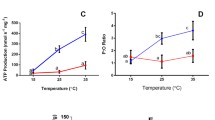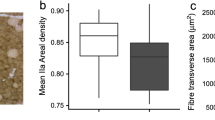Summary
Flight metabolism of locusts has been extensively studied, but biochemical and physiological methods have led to conflicting results. For this reason the non-invasive and non-destructive method of 31P NMR spectroscopy was used to study migratory locusts, Locusta migratoria, at rest and during flight.
-
1.
In the flight muscle of resting locusts the ratio of phosphoarginine to ATP was the same whether determined by NMR (1.76) or biochemically, but the NMR-visible content of inorganic phosphate (Pi) was only 40% of ATP, i.e., much lower than total Pi as determined biochemically. This suggests that most of the Pi in flight muscle is not free, and hence not available as substrate or effector for cytosolic enzymes. Similarly, the free content of ADP and AMP in resting muscle was calculated to be much lower than the total content.
-
2.
Flight brought about a marked increase in Pi and a decrease in phosphoarginine in flight muscle although there was no change in intracellular pH.
-
3.
At the initiation of flight a new ‘steady state’ of ATP, Pi, and phosphoarginine was rapidly established and minimal changes occurred after the first 2 s of flight.
-
4.
From the free contents of ATP and phosphoarginine in working flight muscle the flight-induced fractional increases in free ADP and free AMP were calculated to be 5.0-fold and 27.4-fold, respectively. As Pi, ADP, and AMP are substrates and potent effectors of enzymes, the flight-induced increase in their contents is likely to have marked effects on metabolic flux in working muscle.
-
5.
After short-term flight as well as prolonged flight, phosphoarginine, ATP, and Pi returned rapidly to their preflight levels, indicating that metabolic recovery from flight is rapid.
-
6.
The locust appears to be an appropriate model for the study of metabolic regulation in aerobic muscle during exercise.
Similar content being viewed by others
Abbreviations
- NMR :
-
nuclear magnetic resonance
- PArg :
-
phosphoarginine
- P i :
-
inorganic phosphate
- ppm :
-
parts per million
- T 1 :
-
spin-lattice relaxation time
References
Balaban RS (1990) Regulation of oxidative phosphorylation in the mammalian cell. Am J Physiol 258 (Cell Physiol 27):C377-C389
Beenakkers AMTh, Van der Horst DJ, Van Marrewijk WJA (1984) Insect flight muscle metabolism. Insect Biochem 14:243–260
Beis I, Newsholme EA (1975) The contents of adenine nucleotides, phosphagens and some glycolytic intermediates in resting muscle from vertebrates and invertebrates. Biochem J 152:23–32
Burt CT, Glonek T, Barany M (1976) Analysis of phosphate metabolites, the intracellular pH, and the state of adenosine triphosphate in intact muscle by phosphorus nuclear magnetic resonance. J Biol Chem 251:2584–2591
Crabtree B, Newsholme EA (1975) Comparative aspects of fuel utilization and metabolism by muscle. In: Usherwood PNR (ed) Insect muscle. Academic Press, London, pp 405–500
Downer RGH, Matthews JR (1977) Production and utilisation of glucose in the American cockroach Periplaneta americana. J Insect Physiol 23:1429–1435
Ellington WR (1989) Phosphocreatine represents a thermodynamic and functional improvement over other muscle phosphagens. J Exp Biol 143:177–194
Ellington WR, Wiseman RW (1989) Nuclear magnetic resonance spectroscopic techniques for the study of cellular function. Adv Comp Environm Physiol 5:77–113
Gadian DG (1982) Nuclear magnetic resonance and its applications to living systems. Oxford University Press, Oxford, New York
Gadian DG, Radda GK, Richards RE, Seeley PJ (1979) 31P NMR in living tissue. The road from a promising to an important tool in biology. In: Shulman RG (ed) Biological applications of magnetic resonance. Academic Press, New York, pp 463–535
Graham RA, Ellington WR, Chih CP (1986) A saturation transfer phosphorus muclear magnetic resonance study of arginine phosphokinase in the muscle of a marine mollusc. Biochim Biophys Acta 887:157–163
Hultman E, Sjöholm H (1986) Biochemical causes of fatigue. In: Jones NM, Mc Cartney N, McComas AJ (eds) Human muscle power. Human Kinetics Publ., Champaign, Illinois, pp 215–238
Kammer AE and Heinrich B (1978) Insects flight metabolism. Adv Insect Physiol 13:133–228
Kirsten E, Kirsten R, Arese P (1963) Das Verhalten von freien Aminosäuren, energiereichen Phosphorsäure-Verbindungen und einigen Glykolyse- und Tricarbonsäurecyclussubstraten in Muskeln von Locusta migratoria bei der Arbeit. Biochem Z 337:167–178
Krebs HA (1975) The August Krogh principle: “For many problems there is an animal on which it can be most conveniently studied”. J Exp Zool 194:221–226
The Locust Handbook (1966) The Anti-Locust Research Centre, London
Meyer RA, Brown TR, Kushmerick MJ (1985) Phosphorus nuclear magnetic resonance of fast- and slow-twitch muscles. Am J Physiol 248:C 279-C 287
Moon RB and Richards JH (1973) Determination of intracellular pH by 31P magnetic resonance. J Biol Chem 248:7276–7278
Morrison JF (1973) Arginine kinase and other invertebrate guanidino kinases. In: Boyer PD (ed) The enzymes, Vol. 8. Academic Press, New York, pp 457–486
Newsholme EA, Beis I, Leech A (1978) The role of creatine kinase and arginine kinase in muscle. Biochem J 172:533–537
Ogawa S, Rottenberg H, Brown TR, Shulman RG, Castillo CL, Glynn P (1978) High-resolution 31P nuclear magnetic resonance study of rat liver mitochondria. Proc Natl Acad Sci USA 75:1796–1800
Roberts JKM, Wade-Jardetzky N and Jardetzky O (1981) Intracellular pH measurements by 31P nuclear magnetic resonance. Influence of factors other than pH on 31P chemical shifts. Biochemistry 20:5389–5394
Rowan AN and Newsholme EA (1979) Changes in the contents of nucleotides and intermediates of glycolysis and the citric acid cycle in flight muscle of the locust upon flight and their relationship to the control of the cycle. Biochem J 178:209–216
Schmidt H, Wegener G (1990) Glycogen phosphorylase in fish muscle: Demonstration of three interconvertible forms. Am J Physiol 258 (Cell Physiol 27):C 344-C 351
Schneider A, Wiesner RJ, Grieshaber MK (1989) On the role of arginine kinase in insect flight muscle. Insect Biochem 19:471–480
Storey KB (1980) Regulatory properties of hexokinase from flight muscle of Schistocerca americana gregaria. Role of the enzyme in control of glycolysis during rest-to-flight transition. Insect Biochem 10:637–645
Vaandrager SH, van Marrewijk WJA, Beenakkers AMTh (1987) Kinetic properties of glycogen phosphorylases a ab, and b from flight muscles of the locust, Locusta migratoria. Insect Biochem 17:695–700
Veech RL, Lawson JWR, Cornell NW, Krebs HA (1979) Cytosolic phosphorylation potential. J Biol Chem 245:6538–6547
Vogell W, Bishai FR, Bücher Th, Klingenberg M, Pette D, Zebe E (1959) Über strukturelle und enzymatische Muster in Muskeln von Locusta migratoria. Biochem Z 332:81–117
Wegener G (1990) Elite invertebrate athletes: flight in insects, its metabolic requirements and regulation and its effects on life span. In Nazar K, Terjung RL, Kaciuba-Uscilko H, Budohoski L (eds): International perspectives in exercise physiology. Human Kinetics Publ., Champaign, Illinois, pp 83–87
Wegener G, Michel R, Newsholme EA (1986) Fructose 2,6-bisphosphate as a signal for changing from sugar to lipid oxidation during flight in locusts. FEBS Lett 201:129–132
Wegener G, Beinhauer I, Klee A, Newsholme EA (1987) Properties of locust muscle 6-phosphofructokinase and their importance in the regulation of glycolytic flux during prolonged flight. J Comp Physiol B 157:315–326
Weis-Fogh T (1952) Fat combustion and metabolic rate of flying locusts (Schistocerca gregaria Forskál). Philos Trans R Soc London B 237:1–36
Worm RAA, Beenakkers AMTh (1980) Regulation of substrate utilization in the flight muscle of the locust, Locusta migratoria, during flight. Insect Biochem 10:53–59
Author information
Authors and Affiliations
Additional information
Dedicated to Professor Dr. Ernst Zebe (University of Münster) on occasion of his 65th birthday.
Rights and permissions
About this article
Cite this article
Wegener, G., Bolas, N.M. & Thomas, A.A.G. Locust flight metabolism studied in vivo by 31P NMR spectroscopy. J Comp Physiol B 161, 247–256 (1991). https://doi.org/10.1007/BF00262305
Accepted:
Issue Date:
DOI: https://doi.org/10.1007/BF00262305




